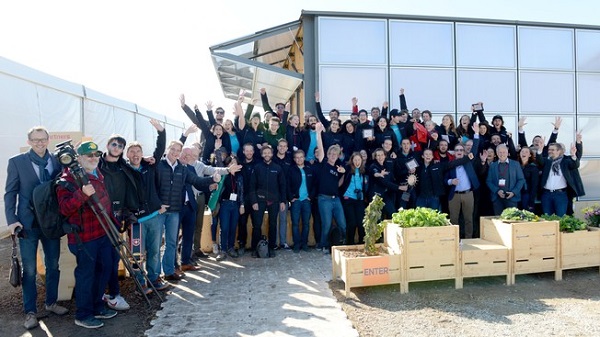The Swiss team and their solar house, the NeighborHub, won the prestigious Solar Decathlon 2017 competition in the Unites States. The Swiss Living Challenge and its multidisciplinary team – 4 schools, 250 students (44 in Denver), 150 supervisors from the professional and academic sectors, and close to 50 sponsors – culminated with the highest award. This unique experience is not only an important victory, but also an unforgettable and educational human adventure.
After more than two years of intense preparation, the Swiss team can be proud of the performance of its students. All in all, over 250 students contributed in the design and construction of their solar house called NeighborHub, big winner of the international sustainable housing competition Solar Decathlon 2017. The 44 solar decathletes surpassed themselves on the competition site in Denver to build and show visitors around their house. «During the construction phase, I was impressed by the team’s determination. It was really hard, we were wet, tired, and cold, but everyone was driven by the project, because deep down, we believed in it.», says Florian Meyer, telecommunications student. The house travelled over 10’000 kilometers through the ocean, rail and road; a perilous route made even more difficult by hurricanes Harvey and Irma. Architecture students, Axelle Marchon and Sarah Sauthier, say: «At the beginning we were scared because of the missing container. During the construction phase, we were in survival mode. And finally, regarding the community house concept, we thought we could either make it or completely break it! We started believing in it when the first results were announced. At that moment, the house was up and running, and we said to ourselves that we are really participating in the competition!»
A risky bet that paid off
The NeighborHub, a solar community house, convinced the jury, and was awarded eight contests out of ten – six of them in the first place! One interesting conclusion about the competition is the fact that the juries either loved our unusual concept and granted us awards for it or considered it off-topic and penalized it. As a reminder, the Swiss team made the audacious bet of coming up with a different concept, proposing a house at the service of a community, rather than a family home. Most members of the jury appreciated the boldness of the concept, by granting the first place on the following contests: architecture, water management, health and comfort, home life, energy, and engineering, that is to say, six contests out of ten! The team was awarded the second place in appliances, and the third place in communications.
The bet is won, and the Swiss team wins the competition with a solid lead of 50 points. «Such a big gap is rare!», says Linda Silverman, Solar Decathlon 2017 director.
Team cohesion, the greatest triumph
A natural explanation of this great success, would be the synergy and convergence of people from different backgrounds towards a shared goal: architects, engineers, as well as communicators and economists. Joëlle Baehr-Bruyère, civil engineering student says: «Everybody was curious about one another’s disciplines. There was a strong intellectual energy! This dynamic, this emulation, was extremely rewarding».
They all looked for and found a common language. That was the greatest challenge during these three years of co-creation : «It took time to put in place a common language, but once we made it, everything started flowing, even though there was over 40 of us working together!», says Marin Thaller, architecture student. «Everybody struggled to make themselves heard and to have a chance to bring what mattered to them in the project. So yes, we all had to make concessions, but now we are all very proud, because the project is consistent, everything is well integrated, and everything’s been pushed to the limit», adds Alexandre Rychner, architecture student.
Values put to the test
This adventure could not have been possible without the expertise provided by the four partner schools (EPFL, HEIA-FR, HEAD and UNIFR), the unfailing support from 48 partners with their expertise and know-how. Students were well aware of their chance to have such generous partners. Marin Thaller, architecture student, explains: «We made powerful connections with our partners, and that may lead to employment.»
The strength of the Swiss team consists in its multidisciplinary cohesion; everybody went along with it, regardless of their background. Joëlle Baehr-Bruyère, civil engineering students says: «We worked together, and we succeeded together. We helped and carried each other.» The Swiss team applied the NeighborHub values all the way through by making the sharing element the key of their success.
This project also provided the students with a unique, unforgettable, and inspirational learning opportunity. Xavier Tendon, environmental sciences and engineering student, is full of enthusiasm when it comes to speaking about the practical skills acquired: «I have learned to build a solar thermal system from A to Z. I’ll install one at home later, that’s for sure!»
The Swiss Living Challenge will be long remembered as a pioneering project providing a unique learning and sharing framework for its students, a real school of life. Fanny Mignon, architecture student concludes: «What we experienced, that’s sounds just incredible to me!»
The main Swiss Living Challenge partners are:
Institutional partners : Swiss Federal Office of Energy (SFOE), Canton of Fribourg, City of Fribourg, smart living lab
Diamond partners: Groupe E, Landolt & Cie SA and Sandoz Family Foundation
Gold partners: JPF-DUCRET, Regent, La Mobilière, Setimac
To check all partners: https://www.swiss-living-chalenge.ch/en/partenaires



















